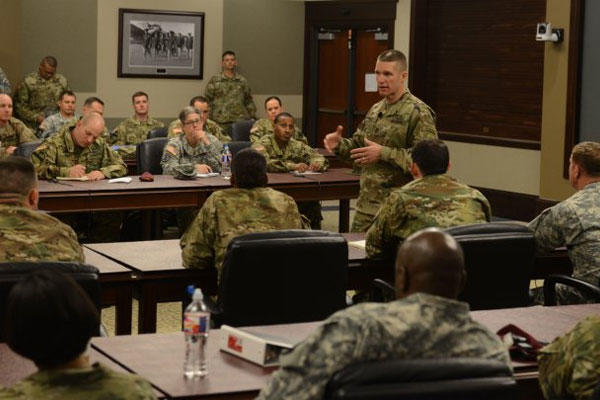FORT LEAVENWORTH, Kan. — Dozens of noncommissioned officers, or NCOs, applauded when one of their own asked Sgt. Maj. of the Army Daniel A. Dailey to try and "hold off making any more uniform changes for a while."
Dailey replied to the NCOs — half of whom were wearing Operational Camouflage Patterns, or OCPs, the other Army Combat Uniforms, or ACUs — "I don't want to make any more changes."
He then qualified the remark: "I'm working hard to minimize changes, but I'd be lying if I promised you there'd be no more changes." He joked that he's becoming known as the "black socks and tattoo" sergeant major.
Dailey fielded questions at the end of the chief of staff of the Army-sponsored Noncommissioned Officer Solarium II, held at the U.S. Army Command and General Staff College here, Nov. 20.
When changes are made, Dailey said it's normally by consensus. As a rule of thumb, a consensus is roughly 60 percent. He said he gets that percentage by surveying Soldiers, a process of informing leadership from the bottom up.
As for examples of consensus in action, Dailey referred to a uniform survey conducted in August.
Soldiers were surveyed about making the blue service cap be the required headgear with the Army Service Uniform for senior NCOs, officers and warrant officers, instead of the beret. Just over half of the respondents favored the change, but the 60 percent threshold wasn't met.
A female NCO seated nearby then told Dailey that she was passionate about the need for one cap for all.
Dailey said he'd heard from others who agreed with her and some who just as passionately didn't. For example, one female Soldier he spoke to said she appreciates the two version because she likes the genders to be differentiated in their apparel.
There could be times in the future when changes will be made without survey or convention, irrespective of opinion, he said. A good example would be a change to the uniform that results in providing the Soldier a greater level of protection.
Dailey then provided insights into what he and the Army chief of staff's personal favorites are. He said they both have nostalgia for period uniforms, like those worn during World War II. They both were happy to see the return of the Ike jacket, for instance.
However, he said their own biases would not have much of a bearing on any future changes.
Regarding the change from ACUs to OCPs, Dailey said that in a way, enlisted Soldiers are fortunate to have a clothing allowance that will completely pay for the new uniforms over the phase-in period. Officers bear that expense from their own pay.
Lastly, Dailey advised having an open mind to changes of any type to avoid stagnating.
COMBAT IN SYRIA?
Another NCO wondered whether or not Soldiers would be battling the Islamic State in Syria or elsewhere within the next 18 months.
Dailey said that would be hard to predict and he didn't have any inside knowledge on that. He did, however, offer his personal assessment.
With the recent attacks in Paris and elsewhere, he said there's a growing concern globally, and that the reality of the severity of the threat is just setting in. He said he believes one of the main reasons another attack hasn't yet happened on the homeland is because of worldwide involvement of the United States and others, including the some 190,000 Soldiers serving abroad in 90 countries.
He harkened back to the Army chief of staff's main focus of being deployable and ready at all time to fight and win the nation's wars. "The only certainty is uncertainty for the future," he added.
ON LEADERSHIP
"We own the world's intellectual capital. We have the most intelligent NCOs, officers and Army civilians," said Dailey regarding the quality of Army leaders.
But there's always room for growth, he added.
Lt. Gen. Robert B. Brown, commander, Combined Arms Center, followed Dailey's closing remarks with his own, regarding leadership.
"A sergeant in the Army does what a colonel or brigadier general does in the Chinese army," he said, regarding responsibility and taking the initiative.
"We have mission command empowering leaders like you," he continued. NCOs at the small-unit level are making strategic decisions.
"You are the Army's 'trusted professionals,'" he added, recalling a previous solarium where that phrase was suggested and adopted by the Army.
ON SCHOOLS
Brown hailed the new Army University as being the most revolutionary step in education that the Army has taken since 1881, when Army Chief of Staff Gen. William Tecumseh Sherman first established Army school houses at Leavenworth and elsewhere.
He said Army University was created not to compete with, but to collaborate with other excellent American universities. At one time, all of the Army schools were stove-piped, he said, now they're synchronized and they must, because the Army no longer has the luxury of infusing good ideas across the school houses over a long period of time. The world has changed and good ideas need to flow faster.
Brown provided an example of stove-piping. At one time, there were 100 doctors of philosophy here, helping only students at the Army Command and General Staff College. Now, he said, they're helping everyone across the force.
The other thing the Army is doing is working to provide Soldiers college credit for the Army education courses and certifying Soldiers for the job-related training. For instance, when a Soldier separates and goes into welding, the difference between having welding certification and not is $50,000 per year. Certified welders earn an average of $80,000 annually and those who are not certified average $30,000.



























